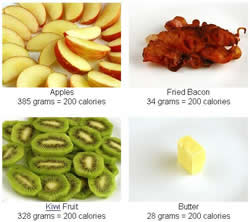Difference between Calories and Fat
Key Difference: Calorie is a pre-SI metric unit of energy. Fats are the fatty acid esters of glycerol and are the primary energy depots of animals.
In a fitness obsessed world, the words fat and calories are constantly heard. Many people try and lose weight by keeping in check their calorie intake. Calories and fat are two different terms and refer to two different things. Calorie is a unit of energy that is acquired when food is consumed and digested. On the other hand, fats are energy depots are used for storing energy.

Calorie is a pre-SI metric unit of energy. Nicolas Clément was the first person to define it as a unit of heat in 1824, but it has now been replaced by joule. However, it is still popularly used to denote unit for energies in the field of chemistry as well as food energy. According to Merriam Webster, calorie can fall into two different definitions. “The small calorie or gram calorie (symbol: cal) approximates the energy needed to increase the temperature of 1 gram of water by 1 kelvin at standard atmospheric pressure (101.325 kPa). The large calorie, kilogram calorie, dietary calorie, nutritionist's calorie or food calorie (symbol: Cal) approximates the energy needed to increase the temperature of 1 kilogram of water by 1 kelvin. This is exactly 1,000 small calories or approximately 4.2 kilojoules.”
When a person intakes a food that lists 15 calories, it actually denotes 15,000 calories, similarly when a person loses 15 calories, this also means that they lose 15,000 calories. The food energy is usually denoted in terms of kilocalories, which means 1 kilocalorie = 1,000 calories. However, calories are not bad and are required for an organism to survive. The body requires six nutrients in order to survive: Carbohydrates, Vitamins, Minerals, Proteins, Water and Fats. Only fats, carbohydrates and proteins provide a person with calories. Any food that a person eats gets digested and gives off calories. The only difference is some foods offer less calories and more nutrients, while other foods are high in calorie and offer fewer nutrients. Carbohydrates and proteins provide around 4 calories per gram, while fats provide 9 calories per gram.
 Fats are a sub-group of lipids and are known as triglycerides. Fats are the fatty acid esters of glycerol and are the primary energy depots of animals. The energy depots are used for storing energy that may be required by the body during deprivation of food. Fats are generally soluble in organic solvents and insoluble in water. Fats can be found in solid state as well as liquid state at room temperature; solid state is known as fats, while liquid state is referred to fat at liquid state. The term ‘lipid’ is used to refer to fat at both liquid and solid state, in a medical or biochemical context.
Fats are a sub-group of lipids and are known as triglycerides. Fats are the fatty acid esters of glycerol and are the primary energy depots of animals. The energy depots are used for storing energy that may be required by the body during deprivation of food. Fats are generally soluble in organic solvents and insoluble in water. Fats can be found in solid state as well as liquid state at room temperature; solid state is known as fats, while liquid state is referred to fat at liquid state. The term ‘lipid’ is used to refer to fat at both liquid and solid state, in a medical or biochemical context.
Fats play an important part in chemical and metabolic functions. Fats are broken down in a human body by enzymes called lipases, which are produced in the pancreas. Human bodies also have an adipose tissue, which is known as a fat depot and is a loose connective tissue composed of adipocytes. This tissue is compose of roughly 80% fat and is located beneath the skin, around internal organs, in bone marrow and in breast tissue. The main role of this tissue is to store energy in the form of lipids. An excess of this tissue causes obesity in humans.
Fats can be categorized into saturated fats and unsaturated fats. Unsaturated fat can be further divided into cis fats and trans fats. Edible fats include lard, fish oil, butter/ghee, whale blubber, peanut, soya bean, sunflower, sesame, coconut and olive oils, and cocoa butter, and margarine. These fats are healthy in a certain limit, but excess of these can cause a person to have too much fat and become obese.
Fats and other works provide calories, which works as energy in order to run our bodies. If there was no energy in the body, a person would not be able to perform daily functions. Hence, fats in small amount are beneficial for the body. However, an excess of fatty foods can cause a person to become obese and will negatively affect the body by blocking arteries, etc. So a person should intake calories and fats depending on their lifestyle, such as active lifestyles require more calories, while non-active lifestyles require less calories and fats.
Image Courtesy: fitnish.co.za, health.msn.co.nz









Add new comment